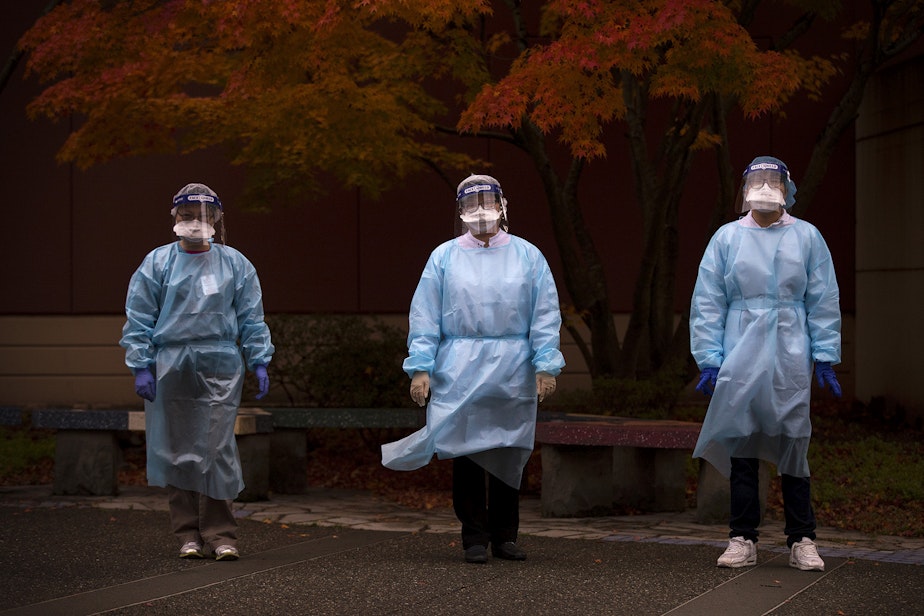Where are people getting Covid? Here are the most common places in King County

Spoiler alert: The coronavirus is not just coming from one place.
We’re getting it at home.
We’re getting it at nursing homes, clinics and hospitals.
We’re getting it at work.
We’re getting it at get-togethers with friends and family, at restaurants and our place of worship.
And we’re getting it by getting close to others with Covid-19 – wherever they may be.
Sponsored
Covid is everywhere, in other words. That marks a shift from the beginning of the pandemic, when outbreaks were primarily at nursing homes and in health care facilities. But nine months in, where you are most likely to contract the virus depends on your age, your race, and which part of the county you call home.
Public Health – Seattle & King County published a report today detailing where most of the 37,482 people who have had a confirmed case of Covid-19 probably contracted the illness in the county, as of November 20.
KUOW has been asking Public Health for this data since September.
The report is one more clue in the complex whodunit of coronavirus transmission in the Puget Sound region.
What this report tells us is “the where,” but not necessarily the “who,” “how” or “why” the virus is spreading.
Sponsored
Where we’re getting Covid in the county changes depending on who you are and where you live, according to an analysis in the report covering data from September 22 to November 20.
For example, nearly a third of Native Hawaiians and Pacific Islanders with a confirmed case of Covid-19 got the virus at home.
For Alaska Natives and American Indians, their workplace was the biggest place they contracted the virus.
The home and workplace were equally thought to be the most common places Latino/x contracted the virus—each representing more than a quarter of cases.
While the household was the biggest site of transmission for Black people, Covid transmission in healthcare settings has had a disproportionate impact – more than one in seven Black people with Covid probably got it from somewhere like a hospital, clinic or long-term care facility, more than any other racial or ethnic group.
Sponsored
The largest likely transmission source for white people in the county was not at home, but in the community and at social gatherings. One in four white people with Covid got the virus while socializing, going to restaurants, a place of worship or a store, including grocery stores.
Essential workers comprised 29 percent of cases.
Social and community settings were where 18 to 24 year olds most often got Covid – more than a third of their cases.
And for people age 75 and older, healthcare settings – such as hospitals, home health agencies, clinics and long-term care facilities — were the places they most often contracted it.
“This virus spreads very quickly before people know they have symptoms,” said health officer Dr. Jeff Duchin. “Just the few days that are necessary for the case to realize they’re sick, to seek testing, to get that test result, for us to contact them, that’s already spread to several household members.”
Sponsored
When someone tests positive for Covid, they should receive a call from a health worker who interviews them about where they’ve been the past two weeks and who they were in contact with.
Sponsored
Despite those efforts at contact tracing and investigation, public health officials don’t know where exactly over 10,000 people in the county got Covid – 28 percent of cases — because they weren’t able to be interviewed, or public health workers identified two or more places they were exposed to the virus, or no place at all.
Other factors get in the way too: Businesses might not know when customers get sick, and it takes days or weeks for someone infected with Covid to show symptoms and they may not share – or even remember — all the details of their whereabouts.
The places we’re getting Covid are different today than at the beginning of the pandemic in March and April.
Workplaces outside of healthcare are taking up a bigger share of cases – 38 percent since end of September compared to 28 percent since late February.
In March more than half of people who got Covid were patients, healthcare workers and visitors to places like a nursing home or other healthcare facility. Now, fewer than one in ten cases stemmed from there.
Sponsored
The picture looks different depending on where you live.
More than a third of people in north Seattle and Shoreline got Covid from social gatherings or from being out and about in the community – the biggest source of exposure in those areas. Meanwhile in south Seattle and cities such as Renton, Auburn, Kent the most common site people contracted the virus was their home.
The trends show optional activities are sources of Covid infection among white people and people who live in North Seattle and Shoreline. Meanwhile, the locations where Black, Indigenous and people of color are getting Covid are places they have to be – workplaces and their homes.
“Many people of color live in large or multi-generational households which make it harder to limit exposure,” Matias Valenzuela, director of equity for Public Health – Seattle & King County.
If you’re asking yourself what you can do to help those communities, stay home and get better at social distancing, Valenzuela said.
“The more that we can actually have everybody else follow the restrictions, stay away from gatherings, those types of things, it will reduce the amount of disease in the community that is affecting everybody.”

